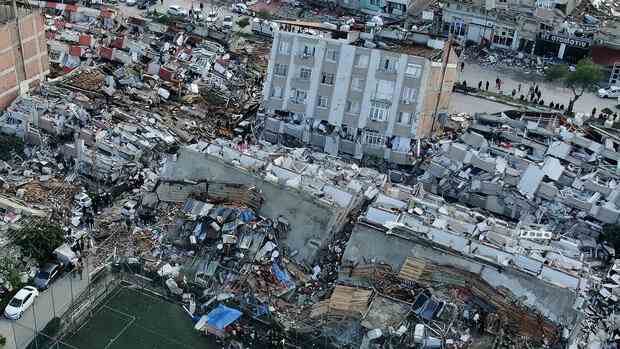Istanbul A day after the terrible earthquakes in Turkey and Syria that killed more than 8,000 people, the extent of the catastrophe is becoming increasingly clear. More than 39,200 people were injured.
In Turkey alone there are at least 5,894 dead and more than 34,810 injured, as Turkish Vice President Fuat Oktay announced late Tuesday evening. In addition, at least 5,775 buildings collapsed as a result of the severe earthquake on Monday. According to the local Ministry of Health and the rescue organization White Helmets, 2,270 people died in Syria.
Turkish President Recep Tayyip Erdogan declared a state of emergency in ten Turkish provinces affected by the quake. Meanwhile, more German relief teams flew to the earthquake area.
Chancellor Olaf Scholz (SPD) promised Turkey further help during a phone call with Erdogan. Foreign Minister Annalena Baerbock (Greens) called for all border crossings to Syria to be opened in order to enable the country to receive help more quickly.
According to information from Tuesday evening, the number of dead is now around 6,200. According to previous information, more than 30,000 people were injured in southern Turkey and northern Syria. According to estimates by the Pacific Disaster Center, a US disaster relief organization, around 23 million people have been affected by the earthquakes in Turkey and Syria.
While aid has started on a large scale in Turkey, many of those affected in Syria are waiting for rescue teams. Foreign Minister Baerbock said there is currently only one open border crossing, which was damaged in the earthquake. “That’s why opening the border crossings is so important.”
All international actors – including Russia – should “use their influence on the Syrian regime so that the humanitarian aid for the victims can also arrive there.” No additional hurdles should be set up.
People are looking for survivors.
(Photo: dpa)
A 7.7 to 7.8 magnitude earthquake struck the area on the border between Turkey and Syria early Monday morning. Another 7.5 magnitude earthquake followed in the same area at noon. Thousands of buildings collapsed. Temperatures in the disaster area were around freezing. The Turkish weather service predicted some snowfall and rain.
Many cannot return to their homes because they have collapsed or it would be too dangerous to return because of the aftershocks. “This earthquake has directly affected 13.5 million of our citizens,” said Turkish Minister of Cities Murat Kurum. Some roads and paths are not accessible, work is being done to make them passable. “The pain is indescribable,” said the minister.
150,000 people in Turkey have become homeless
According to an initial estimate by the International Federation of Red Cross and Red Crescent Societies (IFRC), an estimated 150,000 people in Turkey have become homeless. In southern Turkey’s Kahramanmaras alone, 941 buildings have been completely destroyed, said Interior Minister Süleyman Soylu.
Turkish President Erdogan declared a state of emergency to “ensure that search and rescue and subsequent work is carried out expeditiously”.
In Aalen, volunteers sort relief supplies for the people of Turkey.
(Photo: dpa)
Many countries pledged support. 145 rescue workers even made their way from Mexico. The President of the Federal Agency for Technical Relief (THW), Gerd Friedsam, expected a difficult and possibly longer mission in Turkey just before the departure of a 50-person team from Cologne/Bonn Airport.
27 search and rescue teams have already been mobilized through the EU Disaster Relief Centre. As EU Commissioner Janez Lenarcic announced, this corresponds to a total of more than 1150 rescue workers and 70 dogs.
The EU countries coordinate with each other. Aid pledges also came from Great Britain, Israel, India, Russia, Ukraine, which was attacked by Russia, and the USA. Pictures from Turkey showed how excavators were removing mountains of rubble from collapsed houses.
Many people were also killed in the tremors in Syria.
(Photo: AP)
Rescuers in Syria suspect hundreds of families are still buried under the rubble. One of the hardest hit areas is the Idlib region under rebel control. This makes emergency government aid there more difficult. After more than eleven years of civil war, the government troops of the ruler Bashar al-Assad are again in control of around two-thirds of Syria.
According to the UN, the tremors in the civil war country mainly hit people who were already living in great need. Many of the internally displaced people who lived in dilapidated accommodation before the disaster had to spend the night outside in freezing temperatures, as a spokeswoman for the UN refugee agency UNHCR told the German Press Agency.
Experts assume that there could be earthquakes of a similar size in nearby regions in the near future. The reason for this is stress redistribution, said Marco Bohnhoff from the German Geo Research Center (GFZ) Potsdam of the German Press Agency. More tremors could follow, particularly to the northeast further inland.
More: How the earthquake could lift Syria out of isolation
